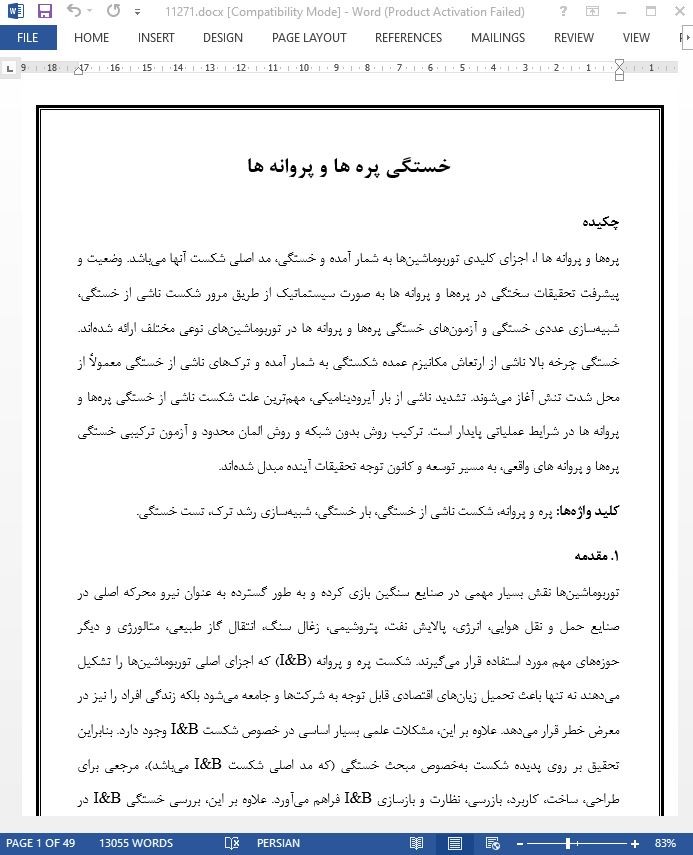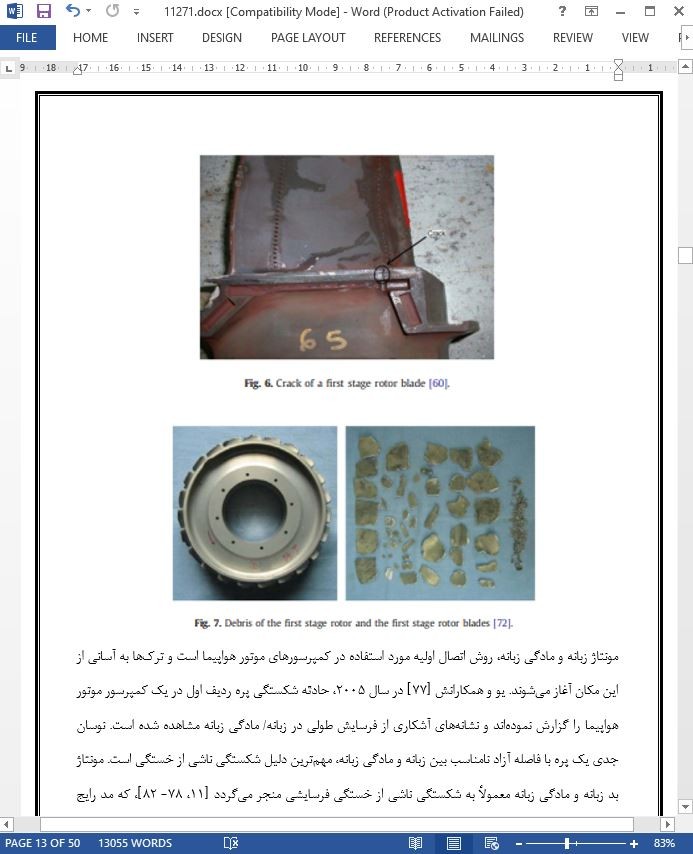
خستگی پره ها و پروانه ها
چکیده
پرهها و پروانه ها ا، اجزای کلیدی توربوماشینها به شمار آمده و خستگی، مد اصلی شکست آنها میباشد. وضعیت و پیشرفت تحقیقات سختگی در پرهها و پروانه ها به صورت سیستماتیک از طریق مرور شکست ناشی از خستگی، شبیهسازی عددی خستگی و آزمونهای خستگی پرهها و پروانه ها در توربوماشینهای نوعی مختلف ارائه شدهاند. خستگی چرخه بالا ناشی از ارتعاش مکانیزم عمده شکستگی به شمار آمده و ترکهای ناشی از خستگی معمولاً از محل شدت تنش آغاز میشوند. تشدید ناشی از بار آیرودینامیکی، مهمترین علت شکست ناشی از خستگی پرهها و پروانه ها در شرایط عملیاتی پایدار است. ترکیب روش بدون شبکه و روش المان محدود و آزمون ترکیبی خستگی پرهها و پروانه های واقعی، به مسیر توسعه و کانون توجه تحقیقات آینده مبدل شدهاند.
1. مقدمه
توربوماشینها نقش بسیار مهمی در صنایع سنگین بازی کرده و به طور گسترده به عنوان نیرو محرکه اصلی در صنایع حمل و نقل هوایی، انرژی، پالایش نفت، پتروشیمی، زغال سنگ، انتقال گاز طبیعی، متالورژی و دیگر حوزههای مهم مورد استفاده قرار میگیرند. شکست پره و پروانه (I&B) که اجزای اصلی توربوماشینها را تشکیل میدهند نه تنها باعث تحمیل زیانهای اقتصادی قابل توجه به شرکتها و جامعه میشود بلکه زندگی افراد را نیز در معرض خطر قرار میدهد. علاوه بر این، مشکلات علمی بسیار اساسی در خصوص شکست I&B وجود دارد. بنابراین تحقیق بر روی پدیده شکست بهخصوص مبحث خستگی (که مد اصلی شکست I&B میباشد)، مرجعی برای طراحی، ساخت، کاربرد، بازرسی، نظارت و بازسازی I&B فراهم میآورد. علاوه بر این، بررسی خستگی I&B در تضمین فعالیت ایمن توربوماشینها بسیار سودمند بوده و از ارائه تحقیقات گسترده بر وری مشکلات اساسی علمی مربوطه در این زمینه پشتیبانی به عمل میآورد.
5. نتیجهگیری
میتوان نتیجه گرفت که:
(1) خستگی سیکل بالای ناشی از ارتعاش، اصلیترین مکانیزم شکست I&B است. شکستهای ناشی از خستگی I&B به وسیله ساختار، عیوب ماده، روشهای فراوری، خوردگی، فرسایش، FOD و دیگر علتهای موجود القا شدهاند. ترکهای ناشی از خستگی معمولاً از موضع شدت تنش آغاز میشوند. میتوان با استفاده از برخی جنبههای طراحی، مواد، ساخت، مونتاژ، عملیات و تعمیرات از شکستهای ناشی از خستگی I&B ممانعت به عمل آورد.
Abstract
Impellers and blades are the key components of turbomachines, and fatigue is the main failure mode of impellers and blades. The status and progress of fatigue research on impellers and blades were systematically introduced through reviewing fatigue failures, numerical simulations of fatigue, and fatigue tests of impellers and blades in several typical turbomachines. High cycle fatigue caused by vibration was the main failure mechanism, and fatigue cracks usually initiated from the location of stress concentration. The resonance caused by the aerodynamic load was the main cause of fatigue failure of impellers and blades in a steady operating condition. The coupling of the meshless method and the finite element method and the combined fatigue test of actual impellers and blades are the developmental direction and research focus of the future.
1. Introduction
Turbomachines play an important role in heavy industry, and have been widely used as the core driving force in aviation, energy, oil refining, petrochemical, coal chemical, natural gas transportation, metallurgy, and other important areas. The failures of impellers and blades (I&B) which are the key components of turbomachines not only cause significant economic losses to enterprises and society, but also threaten people's lives. In addition, there are many fundamental scientific problems about the failures of I&B. Therefore, research on failures, especially on fatigue, which is the main failure mode of I&B, provides references for the design, manufacture, application, inspection, monitoring, and remanufacturing of I&B. Moreover, the study of the fatigue of I&B is beneficial to guarantee the safe operation of turbomachines and gives supports to intense research on relevant fundamental scientific problems.
5. Conclusions
It can be concluded that:
(1) High cycle fatigue caused by vibration is the main failure mechanism of I&B. Fatigue failures of I&B are induced by the structure, material defect, processing techniques, corrosion, erosion, FOD, and other causes. Fatigue cracks usually initiate from the location of stress concentration. Fatigue failures of I&B can be prevented from aspects of design, material, manufacture, assembly, operation, and overhaul.
چکیده
1. مقدمه
2. فرایندهای شکست ناشی از خستگی در I&B نوعی
2. 1. شکست ناشی از خستگی پروانه های کمپرسورهای سانتریفوژی
2. 2. شکست ناشی از خستگی پروانه کمپرسورهای محوری
2. 3. شکست ناشی از خستگی پرههای توربین بخار
2. 4. شکست ناشی از خستگی پرههای توربین دود
2. 5. شکست ناشی از خستگی پرههای کمپرسور موتور هواپیما
2. 6. شکست ناشی از خستگی پرههای توربین موتور هواپیما
2. 7. شکست ناشی از خستگی از پرههای توربین گاز
2. 8. خلاصهای از شکستهای ناشی از خستگی I&B
3. شبیهسازی عددی خستگی I&B
3. 1. محاسبه بار تناوبی I&B
3. 2. جایگزیدگی مد ارتعاشی پروانهها
3. 3. شبیهسازی عددی رشد ترک ناشی از خستگی در I&B
3. 4. خلاصهای از شبیهسازی عددی خستگی I&B
4. آزمونهای خستگی I&B
4. 1. آزمونهای خستگی ارتعاشی I&B
4. 2. آزمونهای خستگی ترکیبی I&B
4. 3. خلاصهای از آزمونهای خستگی I&B
5. نتیجهگیری
1. Introduction
2. Fatigue failures of the typical I&B
2.1. Fatigue failures of centrifugal compressor impellers
2.2. Fatigue failures of axial compressor impellers
2.3. Fatigue failures of steam turbine blades
2.4. Fatigue failures of flue gas turbine blades
2.5. Fatigue failures of aero-engine compressor blades
2.6. Fatigue failures of aero-engine turbine blades
2.7. Fatigue failures of gas turbine blades
2.8. Summary of I&B fatigue failures
3. Numerical simulations of the I&B fatigue
3.1. The alternating load calculations of I&B
3.2. Vibration mode localization of impellers
3.3. Numerical simulations of fatigue crack growth in the I&B
3.4. Summary of numerical simulations of the I&B fatigue
4. Fatigue tests of the I&B
4.1. Vibration fatigue tests of the I&B
4.2. Combined fatigue tests of I&B
4.3. Summary of I&B fatigue tests
5. Conclusions
- اصل مقاله انگلیسی با فرمت ورد (word) با قابلیت ویرایش
- ترجمه فارسی مقاله با فرمت ورد (word) با قابلیت ویرایش، بدون آرم سایت ای ترجمه
- ترجمه فارسی مقاله با فرمت pdf، بدون آرم سایت ای ترجمه



